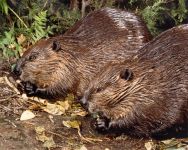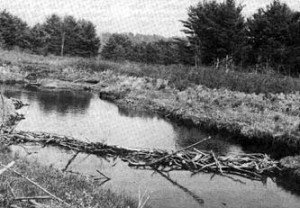


|

|
|
 
|
Beavers are as much a part of waterways as the water itself.

Beavers make many small dams, each based on hydrological principles and maintained regularly so that they hold back water while allowing excess to seep through or flow over. Water impounded behind their dams in rainy times is held in reserve for times when there is no rain.
Water held back along the course of the stream descends in steps over a series of baffles, thus avoiding flooding during sudden or prolonged rains or periods of rapid snow melting. Floods are thus prevented, and the droughts that follow floods (because the water has all rushed away) are minimized.
The reservoirs created by beaver dams slow the flow of water, lessening erosion. In addition, beavers spend much time shoring up the banks of streams by dredging mud and debris from the bottom, swimming with it, one double handful at a time, and after squeezing out excess moisture, depositing it on the bank. These shoreline chores are carried on continuously and persistently.
Beavers continuously maintain the depth of their underwater channels. Their work maintains the waterways in a condition of openness so that flow is not impeded by silting. Beavers must have deep water for safety, and are tireless in this aspect of their work.
Beavers not only eat the bark and leaves of certain trees, they also feed hugely on aquatic growth, including algae. Pickerel weed is a favorite food, as are the roots, stems, leaves and flowers of water lilies and other plants. Beavers slurp up algae and graze on stream-side plants such as marsh purslane. Often their food is alders and other shrub-like plants that tend to clog streams.
The favorite food trees of beavers are poplars and aspens. Beavers also feed on swamp magnolia, swamp maple, birch, sweet and sour gum, and other trees, including an occasional oak, cherry or pine. They prefer to cut trees close to water, thus keeping trees along the waterways thinned, while keeping the water table high for neighboring forests. Because the poplar has long been considered by human beings as a "trash tree," it has become scarce in many places. If allowed to grow – re-introduced with due regard for other trees, if necessary – it would furnish food for beavers.
Because beavers convert many a trickle into a generous body of deep water, they contribute to availability of water for fighting forest fires. The width of the waterway itself may in some cases halt a fire which would otherwise spread to a further shore.
Beaver ponds are wonderful habitat for other creatures. Wood ducks not only live in the ever-flowing streams beavers provide, they also nest in cavities created by large trees girdled and left standing by beavers. Deer and other mammals, as well as a host of birds, come to ponds and streams to drink. Beavers keep water present in times when beaver-less streams are dry, thus providing constant living conditions for aquatic or semi-aquatic life such as frogs, fish, turtles and snakes.
Not just the visible water is an asset, but that stored underground over a wide area because of the beavers' hydrologically sound works, provides a high water table for the whole community drained by the stream.
The beavers have a gift of unique intelligence, are gentle and trusting, and to watch their family life can be an enthralling experience.
The few beavers left in New Jersey are frequently being ousted from their homes by developers or are considered a nuisance if they cut down a tree or create minor flooding. Like human homesteaders, beavers choose a place they find suitable and work hard to make it livable. In the process, they provide stability and livability for others and can even be an asset to people when allowed to live in harmony with their habitat.
Although beavers are presently protected from leghold traps in the state of New Jersey, their siblings in other states are not so lucky. Beavers mate for life. Beavers love their families, and mourn their dead. Beavers suffer mentally and physically when trapped, slowly drowning when the traps are set under water. They may try to escape by gnawing off a foot. If they survive long enough for the trapper to arrive, their fate is certain death, often by being beaten with a club.
Beavers maintain the floodplain, which protects us all. They are as much a part of waterways as the water itself. Beavers are born with a hydrological engineering ability that is not only important for their survival, it is also beneficial to the streams and all who depend on this water.
For centuries, beavers stood between the birthplace of the streams in the mountains and the oceans to which the water by its nature flows. Beavers managed the water all along the way, providing for themselves while contributing to the welfare of their total environment and its inhabitants.
Over sixty years ago, Enos A. Mills, a pioneer naturalist, wrote:
I hope and half believe that before many years every brook that is born on a great watershed will, as it goes swiftly, merrily singing down the slopes toward the sea, pass through and be steadied in a poetic pond that is made and will be maintained by our patient, persistent, faithful friend the beaver.
Let us help make Mills' dream come true.